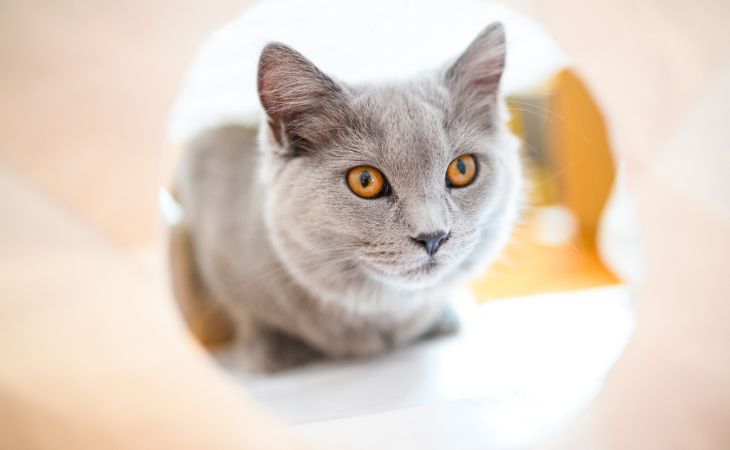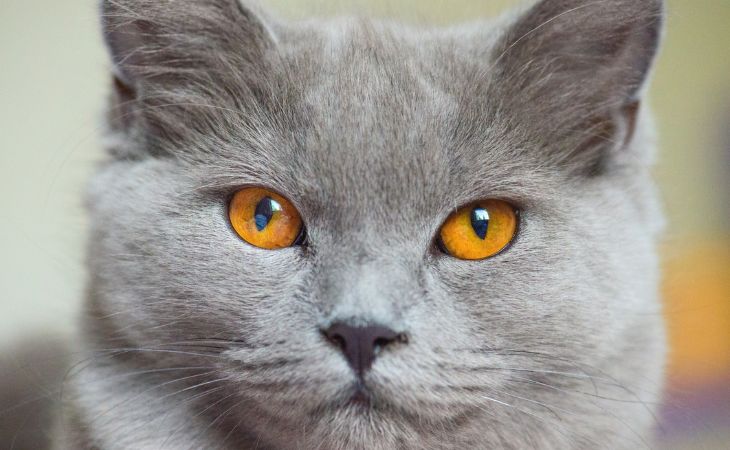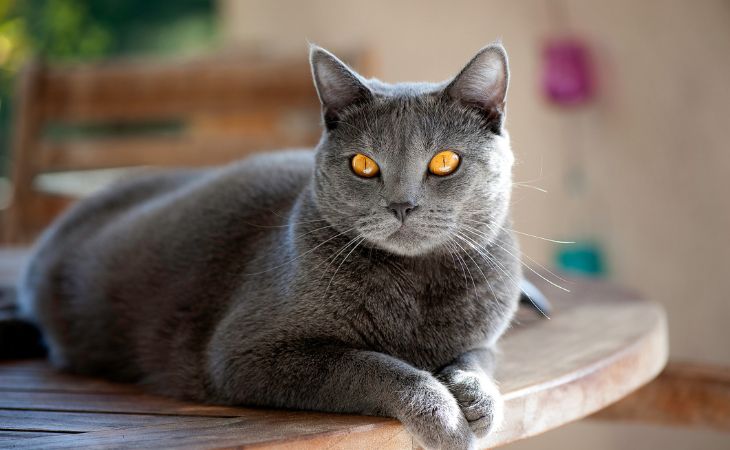Breed standard: CFA, FIFe, TICA, ACFA/CAA, CCA-AFC I Size: Medium I Average lifespan: 15+ years I Temperament: Calm and affectionate I Coat: Short I Origin: France.
To begin with, the Chartreux is an independent, calm, and affectionate cat breed.
The origins of the Chartreux
Famous for its beautiful coat
The Chartreux is famous for its beautiful blue color and copper eyes. The first traces of these blue cats can be traced back to wild cats in the mountains of Syria. This cat breed is believed to have been brought to the West by the Crusaders during the medieval period.
The first mentions of the name “Chartreux” appeared during the 18th century. The name refers to this cat breed’s unique blue color.
During the 20th century, the Chartreux almost went extinct. In fact, in the beginning of the 1930s, only one clowder of Chartreux cats developed on the island of Belle-île-en-Mer. These cats were discovered by the Léger sisters who decided to take care of them to guarantee their survival. Then, the Léger sisters created a cattery. In 1939, the first breed standard for the Chartreux was written.
However, after World War II, the breed almost went extinct. Fortunately, a small group of breeders decided to try to save the breed.
At the end of the 1960s, the Chartreux was frequently crossbred with the British Shorthair. Crossbreeding between these two breeds was authorized. However, the two breeds are considered completely distinct.
Representations of the Chartreux in art and history
In 1558, the Chartreux was mentioned for the first time in a poem called “Vers Français” by Joachim du Bellay. This poem talked about the death of a small cat.
In addition, it appeared in 1747 in a painting done by Jean Baptiste Perronneau.
A second depiction of the Chartreux was also made in 1747 in a painting by Jean-Baptiste Perronneau, Magdaleine Pinceloup de la Grange. In the painting, there is a cat depicted as a house pet, which was rather rare at the time.
In the 20th century, a writer named Colette, who loved this breed and adopted several of them, made her Chartreux cat, Saha, the heroine of her book, La Chatte. She also dedicated descriptions of the breed in Les Vrilles de la vigne.

The character of the Chartreux
What are the Chartreux’s qualities?
The Chartreux is a very observant and intelligent cat breed. As this cat is playful and non-aggressive, they get along very well with children and other animals. They are sometimes considered dog-like cats.
In addition, this cat is not very talkative and rarely meows.
Are there any downsides to having a Chartreux?
While we can’t really say that this is a downside of having a Chartreux, this cat breed is known for being very affectionate. They create a special bond with one person in the family who becomes their favorite human.
The physical characteristics of the Chartreux
General
To begin with, this is a robust, flexible, and agile medium cat breed. They have a strong bone structure and a dense and powerful musculature. The females generally weigh less than the males. Moreover, this cat’s rounded cheeks and narrow muzzle makes them look like they are smiling.
Head
The skull is large with rounded contours on the face. Their cheeks are full and well-developed, notably with males who are older than two years old. The profile of this cat is slightly concave around the eyes with a high forehead and flat between the ears. There is no stop.
The nose is straight, large, and medium length. The muzzle is rather narrow compared to the rest of the head. The legs are well-developed.
They have large, round, and expressive eyes that are copper colored. They are moderately spaced out.
Their ears are narrow at the base and slightly rounded at the tip. They are medium-sized and placed high on the head.
Body
The neck of the Chartreux is thick, strong, and proportionate to the rest of the head and the body. They are also muscular. Their shoulders are large and well-inclined. The chest is deep.
When it comes to the legs, they are medium length. They have a strong bone structure and strong muscles, notably with the males. The paws are slightly oval-shaped.
Lastly, the tail is flexible and medium length. It is thick at the base and becomes narrower over the length of the tail.
Criteria for non-eligibility in competitions
- Stop.
- Snub-nosed or Roman nose.
- Long or heavy muzzle.
- Almond eyes.
- Green eyes or a green ring in the eye color.
- White patches.
- Chartreux with yellow eyes.

Coat, color, and grooming
Coat
When it comes to the Chartreux’s coat, the fur is dense and almost waterproof. It is moderately short. This cat breed has an abundant and slightly wooly undercoat, which gives their coat a certain thickness.
Kittens can have tabby marks on their coat, but they disappear progressively six to twelve months after birth.
Color
The Chartreux is a cat that is known for the unique color of its coat. It can have grayish blue tones, ranging from light grayish blue to a darker grayish blue. Additionally, the color has to be uniform from the root to the ends. The nose has to be slate gray while the lips and paw pads are blue.
Grooming
This cat moults significantly, notably in the spring when they lose their winter fur. For this reason, it is recommended to brush the Chartreux weekly with a comb that has two rows of metal teeth and a more gentle brush.
Did you know?
General De Gaulle had a Chartreux named Gris-Gris who followed him everywhere he went.
The Chartreux at a glance
Size: Around 30 cm (≈ 11.8 in).
Weight: Between 4 and 8 kg (≈ 8.8 and 17.6 lb).
How easy is it to live with a Chartreux? While the Chartreux is an independent cat, it appreciates attention and affection from its owner. These cats are sociable and get along well with other animals.
Are Chartreux cats good with children? These cats are known for their gentleness and are rarely, if ever, aggressive. They also do not show their claws. They prefer to walk away when bothered. For these reasons, this cat breed is an excellent pet for children.
Health: These cats are healthy and do not have any particular health problems.

